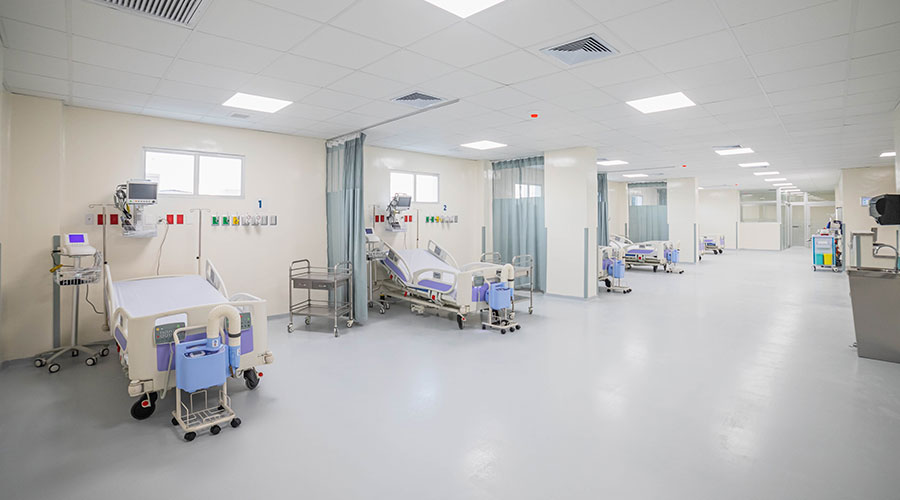Reducing the risk of Legionnaires’ disease is a critical concern in the operation and maintenance of healthcare facilities. These facilities serve especially vulnerable populations and tend to have the complex types of plumbing and mechanical systems most often associated with Legionnaires’ disease outbreaks.
Developing and maintaining a legionella risk management plan is required by most medical facility accreditation agencies and is legally required in some jurisdictions.
What is Legionnaires’ disease?
Legionnaires’ disease is a severe type of bacterial pneumonia caused by the bacterium legionella pneumophila. Early symptoms include fever, headache, muscle aches, and appetite loss. Later, more serious symptoms include high fever, cough, difficulty breathing, and chest pains. Pontiac fever is a less serious illness also caused by legionella bacteria. The term legionellosis is used to refer collectively to Legionnaire’s disease and Pontiac fever.
Although Legionnaires’ disease is relatively rare — about 10,000 cases were reported in 2018 — it is especially prevalent in healthcare facilities and is more dangerous to populations that typically visit and occupy healthcare facilities. As noted in ASHRAE Guideline 12-2020, organ transplant patients, burn patients, chemotherapy patients, immunocompromised patients, smokers, and the elderly are among those known to be more susceptible to the disease.
About 10 percent of Legionnaire’s disease cases are fatal, while 25 percent of cases related to health-care facilities are fatal, according to the Centers for Disease Control and Prevention (CDC). The first known outbreak of Legionnaires’ disease, and the event for which the disease and bacteria was subsequently named, occurred at a 1976 American Legion convention at the Bellevue Stratford Hotel in Philadelphia. The outbreak resulted in more than 200 cases of pneumonia and 34 deaths and eventually was traced to bacteria growing in a cooling tower and thought to have been transmitted via aerosolized water droplets.
Looking for trouble
Legionella bacteria is naturally present and usually harmless in lakes, streams, and ponds. But when allowed to grow in plumbing and mechanical systems, such as the Bellevue Stratford’s cooling tower, concentration of the bacteria can increase to dangerous levels. The most common mode of human infection is inhalation of bacteria-containing water droplets, so any plumbing or mechanical system that has the potential to distribute aerosolized water particles is a potential infection path for legionella.
Legionella grows most readily in stagnant water at 77-108 degrees but can survive at up to 158 degrees. The presence of organic matter, sediment, and scale also promotes legionella growth. Water in stagnant areas tends to have lower concentrations of disinfectant. Most municipal water supplies contain disinfectant chemicals to prevent biological growth in storage and distribution systems. This disinfectant can prevent legionella growth in building systems, but a disinfectant’s concentration decreases over time.
Legionella growth is also facilitated by the formation of biofilms on the internal surfaces of plumbing and mechanical systems. Biofilms can protect the bacteria from unfavorable conditions, such as high water temperatures or chemical biocides. Biofilms also facilitate the buildup of organic matter, even in areas that are sometimes subject to water flow.
Trouble spots
Any water-containing system that sometimes provides the right conditions for Legionella growth is a potential source of infection and must be considered. Among the systems and equipment in facilities that can harbor or transmit legionella are these:
- Potable water systems
- Cooling towers and evaporative coolers
- Ornamental fountains and water features
- Cooling towers and evaporative cooling systems
- Humidifiers
- Pools and spas
- Medical devices
- Spray washers
- Emergency eyewashes and showers
- Fire suppression systems.
Managing legionella risk involves reducing the potential for legionella growth and the likelihood of human exposure to potentially infected aerosols. The latter depends largely on mechanical system design. Mechanical equipment should be located so potential infection sources, such as cooling tower discharges and mechanical system drain outlets, are away from ventilation air inlets, building entrances, and operable windows.
Preventing human exposure to water in some cases is not always possible, such as with potable water systems. Strategies for preventing legionella growth include controlling water temperature, eliminating stagnant areas, keeping the internal surfaces of piping and equipment clean, maintaining residual disinfectant concentration, and performing supplemental chemical treatment.
Strategies for success
ASHRAE Guideline 12-2020 provides comprehensive technical guidance regarding legionellosis control strategies for a variety of systems. Whenever possible, water should be kept below 77 degrees F and above 120 degrees F. Domestic hot water should be stored at or above 140 degrees and distributed at or above 120 degrees where possible. If domestic hot water is distributed at or above 120 degrees, point-of-use mixing valves might be required for scald prevention, since 120 degrees is the maximum allowable delivery temperature according to plumbing codes in many jurisdictions.
One major challenge involves maintaining domestic hot water in distribution piping. Domestic hot water recirculation pumps can help maintain even temperatures in distribution piping, but stagnant areas on smaller branches might not be subject to recirculation flow. If such branches serve seldom-used areas, the water temperature in these areas can drop to levels that support legionella growth. Cycling a domestic hot water recirculation pump off at a temperature that is too low also can allow water in the distribution piping to drop. Proper insulation of domestic hot water piping is critical to controlling water temperature.
Managers cannot effectively employ temperature control strategies for some systems. For example, some mechanical systems operate with water at 77-120 degrees by design. Some potable water systems must contain or deliver water in this temperature range by design — emergency showers and eyewash systems, for example — while some domestic hot water distribution systems are unable to maintain 120-degree distribution temperatures due to mechanical limitations or scald-prevention concerns.
Managers need to employ alternative strategies for such systems. For example, point-of-use filters are available for use on potable water systems. Maintaining the cleanliness of piping systems, storage devices, and heat-exchange equipment reduces the likelihood of legionella growth. The development of biofilms, the presence of organic matter, and the formation of scale and sediment promote legionella growth. Closed-loop mechanical systems must be regularly tested and treated by a qualified water treatment firm and must be as free of leaks as possible.
A properly maintained closed-loop system should not require the additional of large amounts of make-up water, which can introduce organic matter, promote the buildup of scale and sediment, and potentially promote biological corrosion of some piping systems. All of these are potential sources of nutrients and habitat for legionella growth.
Open-loop systems necessarily involve the continual addition of makeup water and can be more challenging. Open-loop storage devices, such as cooling tower sumps, require regular cleaning and blowdown, as well as regular chemical treatment. Piping in open-loop systems should be chemically treated, which might not be possible or as commonly practiced for potable water systems, and regularly flushed.
Stagnant areas should be regularly blown down to ensure that chemical treatment concentrations or residual disinfectant levels are maintained and debris that might support biological growth is not allowed to build up. This includes piping in potable water systems that are rarely used. Equipment that is subject to seasonal shutdown must be drained fully and cleaned as part of the shutdown process.
Stagnant water in piping or equipment that is not completely drained could support bacterial growth or introduce contamination to the system when the equipment is returned to service.
Spotlight: Healthcare
Medical facilities often have specialty equipment such as dental water systems, descalers, CPAP machines, and hydrotherapy equipment, that could facilitate the growth or transmission of legionella to patients.
Managers should always consult medical equipment manufacturer instructions regarding the safe use and maintenance of such devices. In general, distilled water is recommended for use with such devices, and devices should be fully drained and properly cleaned and sterilized between uses.
Every medical facility should have a management structure and a formal legionella risk-management plan tailored to its specific needs. Such a plan should include a regular assessment of a facility’s risks, an up-to-date description of the building’s water systems, identification of specific legionella-related risk areas, a list of control measures and monitoring methods to be used, and a list of individuals or entities responsible for implementing and overseeing the program.
Reviewing the plan
Managers should carry out a review of the risk-management program at least annually, and when substantial changes to a facility’s water-containing systems occur, such as new construction, equipment replacement, or a major change in usage levels. The plan must be well-documented and include a clearly defined method for monitoring plan compliance — maintenance of water temperatures or disinfectant levels — and clearly describe the corrective actions to take if monitoring identifies a failure to meet plan requirements.
ASHRAE Standard 188 and the CDC’s Developing a Water Management Program to Reduce Legionella Growth and Spread in Buildings toolkit provide detailed guidelines for developing a legionella risk-management plan. ASHRAE Standard 188 establishes minimum legionellosis risk management requirements for building water systems, and the CDC toolkit is essentially a practical guide to implementing the strategies outlined in the ASHRAE standard.
Facilities managers should be aware that some jurisdictions legally require the development of a legionella risk-management plan and keep abreast of relevant local legislation. For example, New York state introduced legislation in 2016 requiring, in addition to the registration, testing, and chemical treatment of cooling towers, development of a maintenance program in line with ASHRAE Standard 188 and an annual environmental assessment and legionella culture sampling of potable water systems.
Accreditation agencies such as the Joint Commission also require that managers address risks associated with legionella. Beginning in January 2022, the Joint Commission will require all healthcare facilities to have a fully documented water management program. The Joint Commission’s new requirements specifically reference ASHRAE Standard 188-2018, ASHRAE Guideline 12-2020, and the CDC. ASHRAE Guideline 12-2020 provides technical guidance regarding strategies to control legionellosis.
Ryan Kilgore is a senior project engineer with Horizon Engineering Associates.

 Alleged Ransomware Administrator Extradited from South Korea
Alleged Ransomware Administrator Extradited from South Korea Design Plans Unveiled for New Intermountain St. Vincent Regional Hospital
Design Plans Unveiled for New Intermountain St. Vincent Regional Hospital Ground Broken on New Pediatric Health Campus in Dallas
Ground Broken on New Pediatric Health Campus in Dallas Pre-Construction Strategies for Successful Facilities Projects
Pre-Construction Strategies for Successful Facilities Projects Geisinger Finds Success with Violence Prevention Efforts
Geisinger Finds Success with Violence Prevention Efforts